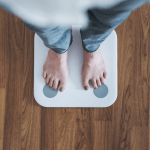Understanding Menopausal Weight Gain
As women approach menopause, they often notice an increase in belly fat even if their overall weight remains stable. This phenomenon is partly due to hormonal changes, particularly the decline in estrogen, progesterone, and testosterone, which influence fat distribution. The shift in hormones can result in a redistribution of fat to the abdominal area, leading to the unwelcome appearance of a ‘muffin top’ despite thinner legs or a smaller rear. Understanding the underlying hormonal changes is crucial for addressing menopausal weight gain and finding effective strategies to combat belly fat.
Health Risks Associated with Belly Fat
Belly fat is not just a cosmetic concern; it poses significant health risks. Visceral fat, which lies deep within the abdomen and surrounds internal organs, is particularly dangerous. It is linked to a higher risk of serious health issues, including cardiovascular disease, type 2 diabetes, certain cancers, and even premature death. A waist circumference of more than 35 inches (89 cm) can indicate an unhealthy concentration of belly fat and a heightened risk of these conditions. Therefore, managing belly fat is not only about improving appearance but also about reducing the risk of potentially life-threatening diseases.
The Role of Hormones in Fat Distribution
Hormones play a pivotal role in where the body stores fat. During the menopausal transition, the decrease in estrogen, progesterone, and testosterone levels leads to a shift in fat storage from the hips and thighs to the abdomen. This hormonal imbalance can also affect metabolism, appetite, and muscle mass, further complicating weight management. Hormone Replacement Therapy (HRT) has been shown to help counteract these effects by restoring hormonal balance, potentially aiding in the reduction of belly fat and improving overall health.
Understanding the complex interplay between hormones and fat distribution is essential for developing targeted strategies to address menopausal weight gain. By focusing on dietary adjustments, exercise routines, and stress management, women can take proactive steps to maintain a healthy weight and reduce belly fat during this transitional phase of life.
The Science of Belly Fat Accumulation
Hormonal Changes and Their Impact on Metabolism
As individuals age, particularly women entering menopause, hormonal changes can significantly impact metabolism. The decline in estrogen levels during menopause is closely linked to a decrease in metabolic rate, which can contribute to weight gain, especially around the abdomen. This hormonal shift can also lead to insulin resistance, where the body’s cells do not respond as effectively to insulin, causing blood glucose levels to rise and increasing the risk of diabetes. Moreover, these hormonal changes can affect appetite and fat distribution, leading to an increased accumulation of visceral fat—the more metabolically active and dangerous type of fat.
Visceral Fat vs. Subcutaneous Fat
Understanding the difference between visceral fat and subcutaneous fat is crucial when discussing belly fat. Subcutaneous fat is the layer of fat that lies directly under the skin, which can be pinched or felt externally. In contrast, visceral fat is stored deeper in the abdominal cavity, padding the spaces between organs. While both types of fat have their implications, visceral fat is particularly concerning due to its association with a host of health issues, including cardiovascular disease, type 2 diabetes, and certain cancers. Visceral fat is not only a storage depot for fat but also functions as an endocrine organ, releasing hormones and pro-inflammatory cytokines that can disrupt the body’s normal hormonal balance.
Factors Contributing to Increased Belly Fat in Menopause
Several factors contribute to the increased accumulation of belly fat during menopause. These include:
- Genetics: Hereditary factors can determine where fat is predominantly stored in the body.
- Lifestyle: A sedentary lifestyle and poor dietary choices can exacerbate the natural tendency to gain belly fat during this stage of life.
- Stress: Chronic stress can lead to an increase in cortisol, a hormone that has been linked to an increase in abdominal fat.
- Sleep Patterns: Both too little and too much sleep have been associated with weight gain, particularly in the abdominal area.
It’s important to note that while menopause can make weight management more challenging, it is not an insurmountable obstacle. Regular physical activity, particularly exercises that increase muscle mass and improve metabolism, along with a balanced diet low in simple sugars and high in fiber, can help mitigate the accumulation of visceral fat. Additionally, lifestyle modifications such as stress reduction techniques and ensuring adequate sleep can play a significant role in managing belly fat during menopause.

Feeling You Have a Right to Safe Beauty & Fem Care?
If so, it may be time for a change. It starts with knowledge. We have a few suggestions in our new guides.
Assessing and Measuring Belly Fat
How to Determine Unhealthy Belly Fat Levels
Understanding the amount of belly fat you have is crucial for assessing health risks. While some fat is necessary for protecting your organs, excessive amounts, particularly visceral fat, can lead to serious health issues. To determine unhealthy levels of belly fat, you can perform a simple “gut check” at home using a tape measure. Wrap it around your waist at the level of the navel, without compressing the skin. For women, a waist circumference of 35 inches or more is generally considered indicative of excess visceral fat. However, it’s important to monitor changes in waist size over time rather than relying on a single measurement.
The Importance of Waist Circumference
Waist circumference is a significant indicator of health risks associated with belly fat. Unlike other fat deposits, visceral fat is located deep within the abdominal cavity and can contribute to various chronic conditions, including cardiovascular disease, type 2 diabetes, and certain cancers. Measuring waist circumference is a straightforward method that can signal whether you’re at an increased risk for these conditions. It’s recommended to measure your waist just above the belly button, ensuring the tape is level and not too tight.
Limitations of BMI in Assessing Health Risks
Body Mass Index (BMI) is a common tool for assessing overall obesity, but it has limitations when it comes to evaluating health risks associated with belly fat. BMI does not differentiate between muscle and fat mass, nor does it provide information on fat distribution. As a result, individuals with a normal BMI could still have a high amount of visceral fat, putting them at risk for health issues. Therefore, waist circumference is a more reliable measure for assessing the dangers of belly fat, as it provides a direct estimate of the fat around the abdominal organs.
In summary, while BMI can be a useful general indicator, it’s essential to combine it with waist circumference measurements to get a clearer picture of one’s health status concerning belly fat. Regular monitoring of waist size, understanding the implications of visceral versus subcutaneous fat, and recognizing the influence of factors such as hormones and lifestyle on fat distribution are all vital components of effectively assessing and managing belly fat.

From unhappy, dry, and sandpaper to silky, smooth and feeling good. That’s Cleo. Cleo is a 100% natural labial balm to moisture and soothe “your other lips”. Cleo is chemical-free, water-free, pH optimized and helps maintain and restore your delicate labial skin’s natural flora. Ideal for daily use or as needed. Get the most silky, lovable lips ever.
Lifestyle Strategies for Reducing Belly Fat
Dietary Adjustments for Hormonal Balance
As we age, hormonal changes can lead to an increase in belly fat, but dietary adjustments can help mitigate these effects. To promote hormonal balance, focus on a diet rich in soluble fiber which can slow down digestion and help you feel fuller longer, potentially reducing overall calorie intake. Foods that are high in soluble fiber are incredibly beneficial for our health and include a variety of items that can be easily incorporated into our daily diet. Flaxseeds, although small in size, are a powerhouse of soluble fiber. They can be easily added to your meals by sprinkling them on your salad or even your favorite smoothie. Besides being a good source of fiber, flaxseeds are also rich in omega-3 fatty acids, which are beneficial for heart health. Brussels sprouts, a type of cruciferous vegetable, are not only high in soluble fiber but also contain a good amount of vitamins K and C. They can be roasted, steamed, or sautéed and make a nutritious addition to any meal.
Incorporating these foods into your diet can significantly increase your intake of soluble fiber, which has been linked to numerous health benefits. These include improving digestion, aiding in weight loss, and reducing the risk of heart disease. So, whether you’re trying to improve your overall health or simply want to add more fiber to your diet, these foods are a great place to start. . Additionally, reducing the intake of trans fats and alcohol can decrease the risk of abdominal fat accumulation. Prioritizing protein is also crucial, as it can increase the release of the fullness hormone peptide YY, helping to maintain muscle mass and metabolic rate during weight loss. Good sources of protein include lean meats, fish, beans, and dairy products.
Effective Exercise Routines for Older Adults
Exercise is essential for overall health and can be particularly effective in reducing belly fat. For older adults, a combination of aerobic exercises and resistance training is beneficial. Aerobic activities such as brisk walking, swimming, or cycling help burn calories and can be adjusted in intensity to suit individual fitness levels. Resistance training, or weightlifting, helps preserve muscle mass, which is crucial for maintaining a healthy metabolism. It’s recommended to engage in at least 150 minutes of moderate aerobic activity or 75 minutes of vigorous activity per week, along with muscle-strengthening activities on two or more days per week.
The Impact of Sleep and Stress on Weight Gain
Sleep and stress play significant roles in managing belly fat. Lack of sleep can lead to hormonal imbalances that increase appetite and cravings, contributing to weight gain. Aim for 7 to 9 hours of quality sleep per night to support weight loss efforts. Stress, on the other hand, can trigger the production of cortisol, a hormone that leads to fat accumulation around the midsection. To combat stress, incorporate relaxation techniques such as yoga, meditation, or deep breathing exercises into your daily routine. By managing stress and ensuring adequate sleep, you can help your body fight against unwanted belly fat.
In conclusion, reducing belly fat involves a combination of dietary adjustments, regular physical activity, and lifestyle changes that address sleep and stress. By adopting these strategies, you can work towards a healthier body composition and reduce the health risks associated with excess belly fat.
By the way, something for you, a little gift!!!
I am just in the middle of publishing my book. It’s about How women can balance their hormones. One part is about food and diet, of course.
Follow this link and enter your email.
I will send you this part of the book for free once the book is published. It has many concrete, practical tips and recipes and will help you feel better during menopause or times of Big hormonal fluctuations.
Annette, Damiva Lead for Health & Wellness

Hormone Replacement Therapy (HRT) and Weight Loss
Understanding HRT and Its Role in Weight Management
Hormone Replacement Therapy (HRT) is a treatment used to alleviate symptoms of menopause by replenishing the body with estrogen and progesterone, hormones that naturally decline during this phase of a woman’s life. While HRT is primarily prescribed to manage menopausal symptoms such as hot flashes, night sweats, and vaginal dryness, it also plays a role in weight management. As estrogen and testosterone levels drop, women often experience a shift in fat distribution, leading to increased abdominal fat. HRT can help mitigate this redistribution of fat by stabilizing hormone levels, potentially aiding in the prevention of menopause-related weight gain.
Benefits and Risks of HRT for Menopausal Women
The benefits of HRT extend beyond symptom relief to potentially include a reduction in visceral fat and an improved metabolic profile. Some studies suggest that women on HRT may have lower levels of belly fat compared to those not on therapy. However, HRT is not a weight loss treatment per se and should not be used solely for this purpose. It is also important to consider the risks associated with HRT, which may include an increased risk of blood clots, stroke, and certain types of cancer. The decision to use HRT should be made on an individual basis, weighing the benefits against the potential risks, and in consultation with a healthcare provider.
Alternative Treatments and Natural Remedies
For those seeking alternatives to HRT for weight management during menopause, several options may be considered. Lifestyle modifications such as a balanced diet rich in fruits, vegetables, and whole grains, regular physical activity, and stress reduction techniques can be effective. Additionally, natural remedies like phytoestrogens found in soy products, black cohosh, and flaxseed may offer some relief from menopausal symptoms and have a positive impact on weight control. It’s crucial to approach these alternatives with caution and under the guidance of a healthcare professional, as their efficacy and safety profiles vary.
Behavioral Changes to Combat Menopausal Belly Fat
The Psychology of Eating and Taste Changes
Menopause brings about not just physical changes but also psychological ones that can affect eating habits. Hormonal fluctuations can alter taste perceptions and cravings, leading to a preference for high-calorie comfort foods. Additionally, emotions such as stress or sadness may trigger emotional eating, which can contribute to belly fat accumulation. To combat this, it’s essential to be mindful of the psychological triggers that lead to overeating. Creating a food diary can help identify patterns and develop strategies to cope with cravings. Moreover, focusing on a nutrient-rich diet that includes plenty of fruits, vegetables, lean proteins, and whole grains can help maintain a healthy weight and balance hormones.
Incorporating More Movement into Daily Life
Physical activity is a cornerstone of weight management during menopause. However, it’s not just about scheduled exercise; incorporating more movement into daily life can significantly impact calorie burn and metabolic health. Simple strategies include standing instead of sitting when possible, taking stairs over elevators, and engaging in active hobbies like gardening or dancing. For those with sedentary jobs, setting reminders to stand or walk every hour can be beneficial. Additionally, strength training is crucial as it helps combat muscle loss associated with aging and boosts metabolism. Tailoring activities to individual fitness levels and finding enjoyable forms of exercise can increase adherence and effectiveness.
Mindfulness and Emotional Well-being
Mindfulness practices can play a significant role in managing menopausal weight gain. Techniques such as meditation and yoga not only reduce stress, which is linked to fat accumulation, but also enhance the mind-body connection, leading to better food choices and improved satiety. Emotional well-being is closely tied to physical health; therefore, addressing mood swings and stress through mindfulness can indirectly aid in weight management. Additionally, ensuring adequate sleep and seeking support for sleep disturbances can prevent the hormonal imbalances that drive appetite and weight gain. Embracing behavioral changes that promote relaxation and emotional balance can be just as important as diet and exercise in the battle against belly fat.
In conclusion, addressing the psychological aspects of eating, integrating more movement into everyday life, and fostering emotional well-being are all effective strategies for managing menopausal belly fat. By understanding and modifying these behaviors, women can improve their overall health and mitigate the risks associated with increased abdominal fat during this stage of life.

Bette 100% All-Natural Relaxing Lavender Body Lotion.
Chemical-Free
Your relaxing night time body moisturizer to leave the day’s stress behind. Decompress and wish your body good night with the calming scent of lavender.
Conclusion: A Holistic Approach to Menopausal Health
Throughout the journey to understand and combat menopausal belly fat, we’ve uncovered several key strategies. A balanced diet rich in fiber, lean proteins, and healthy fats, coupled with regular physical activity, forms the cornerstone of an effective belly fat reduction plan. Strength training and core exercises are particularly beneficial, as they help maintain muscle mass and metabolic rate. Additionally, managing stress and ensuring quality sleep are critical components that influence weight gain during menopause. It’s not just about what we eat or how much we exercise; it’s also about how we care for our mental and emotional well-being.
The Importance of Personalized Care
Every woman’s menopausal journey is unique, and so is her body’s response to lifestyle changes. Personalized care is paramount when addressing menopausal health concerns, including belly fat. Factors such as genetics, pre-existing health conditions, and lifestyle must be considered when crafting a weight loss strategy. Consulting with healthcare professionals can provide tailored advice and support, ensuring that the chosen methods are safe, effective, and sustainable for each individual.
Empowering Women to Take Control of Their Health
Empowerment is a critical aspect of managing menopausal health. Women should be encouraged to take an active role in their health care, educating themselves about menopause and its effects on the body. By understanding the science behind belly fat accumulation and the lifestyle factors that contribute to it, women can make informed decisions about their health. Support groups, educational resources, and professional guidance can all play a role in empowering women to implement the changes necessary to reduce belly fat and improve overall health during menopause.
In conclusion, losing belly fat during menopause requires a holistic approach that encompasses diet, exercise, stress management, and sleep. Personalized care is essential, as it respects the individuality of each woman’s experience. By empowering women with knowledge, support, and the right tools, we can help them take control of their health and navigate the challenges of menopause with confidence and grace.


















